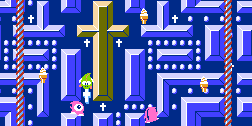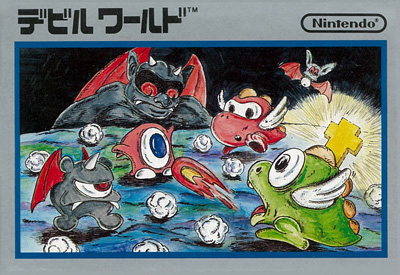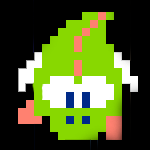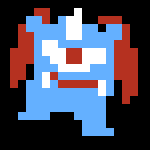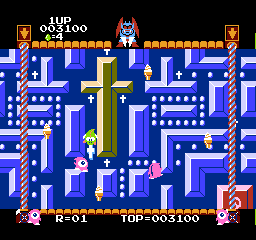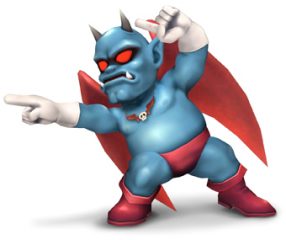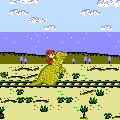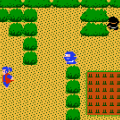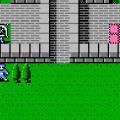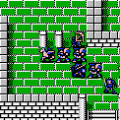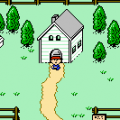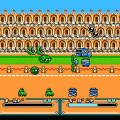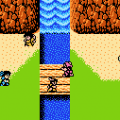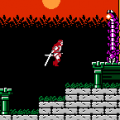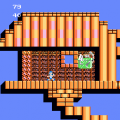Shigeru Miyamoto, simply put, is a legend in the gaming world. As creator of the Super Mario Bros. and The Legend of Zelda series, it can be argued that Miyamoto was one of the visionaries who helped a generation of Americans fall in love (again) with console games after the infamous Atari crash. Many of his works are celebrated by Nintendo of America, often receiving re-releases or special editions, except for one: Devil World, a 1984 Famicom release which has the dubious distinction of being a Miyamoto game which never reached the US.
Devil World also has the distinction of being the first game Takashi Tezuka worked on for Nintendo, and the first game that Miyamoto and Tezuka worked on together; Miyamoto supplied the ideas, Tezuka designed the images. This partnership would continue on to nearly every Mario and Zelda game and is still strong to this day, with both men holding the title of General Manager of the Software Development Department in EAD.
Like the majority of early Famicom games, Devil World was short on plot. Taken from a translation of the Famicom manual: you are Tamagon, a tiny green dragon who is lost and ends up in the Devil’s realm. Where Tamagon comes from or how he manages to find himself in the Devil’s realm is never mentioned. The Devil, as you’d expect, isn’t the most hospitable person so he looks to destroy Tamagon before he can find an exit.
In addition to Tamagon and the Devil, there are three additional enemies.
Characters
Tamagon
Tamagon is the protagonist of our story; he loves to eat, with his favorite food being ice cream. Tamagon’s name is derived from Tamago (the Japanese word for egg) and Dragon. When a two player game is selected, the second player is a red version of Tamagon.
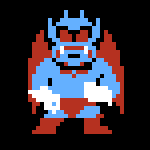
Devil
Devil is the antagonist of the story and the ruler of the Devil World, which is named after him. While some have incorrectly attributed him to Satan or other named religious devils, he is simply called Devil throughout the game.
Medaman
A pink creature with one eye that almost perfectly resembles Waddle Doo from the Kirby series. When he is attacked by Tamagon, he turns into a Fried Egg that can then be eaten for points. Medaman will chase Tamagon throughout the maze to a small degree.
Co-Devil
A miniature blue version of the devil that only appears during the second scene of every round. He cannot be defeated; shooting a fireball at him only makes him walk in the opposite direction. He does not chase Tamagon throughout the maze.
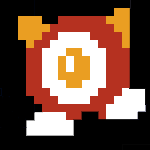
Bon-Bon
Bon-Bon is a palette swap of Medaman, replacing the pink for orange and his eye for the Fried Egg sprite, for some odd reason. When defeated, he either turns into a Fried Egg, or his body dissolves and leaves his eye. Either way, it can also be eaten for points. Bon-Bon is aggressive and will chase Tamagon through the maze. He first appears in Round 7.
As noted above, Devil World is a one- or two-player game where both play at the same time. Each player shares his own life stock, which starts at four extra lives. Once your mode of play is selected, you are told to “Attack the Devil’s World!” – which doesn’t make a lot of sense. Isn’t Tamagon merely lost and defending himself? As this is the only cutscene, we’ll never know for sure. After this scene, you are immediately thrust into the game.
Devil World is often called a Pac-Man clone, but this is only half-true. Each round consists of two scenes with a bonus scene at the end; each successive round becomes more difficult than the last due to an increase in game speed and enemy count. Devil World, much like other games of its type, is endless; rounds continue indefinitely until you run out of lives. However, after the 16th round the difficulty stops scaling for the remainder of the game, which at that point is either when you run out of lives or turn the system off. A counter at the bottom of the screen lets you know what round you are on.
The first scene is structured like Pac-Man and similar titles of the era; hence the reputation for being a clone. The objective is to eat the Boa-Boa dots scattered throughout each maze. However, to eat the dots, Tamagon must be holding a cross, the first of a few religious references made throughout. When holding a cross, which are found scattered throughout the maze, Tamagon also gains the ability to breathe fire and defeat his enemies. Once all of the Boa-Boa dots are eaten, the second scene commences.
Taking place in the same maze, the second scene changes things up a bit. Gone are the Boa-Boa dots, replaced instead with four bibles in the four corners of the screen. Each of these bibles must be placed into one of the four slots of the Devil Hole; the box with the skull and crossbones logo on it in the center of the maze. Once this is completed, the Devil morphs into a bat and flies away angrily, ending the round. Overall the second scene is much easier than the first as Co-Devil, an enemy exclusive to this second round, never really provides much of a challenge.
In both rounds you must also contend with a moving border. This border is controlled by the Devil himself, who stands at the top of the screen barking out orders to four overworked Medamans who are powering it (well, what did you expect, he is the Devil). As he points in a direction the border moves in the opposite direction – meaning Devil World perpetually scrolls. If Tamagon is caught between the border and a section of the maze he is crushed and loses a life. If the enemies are caught between in a jam they turn into ghosts and float to a new section of the maze. However, while they cannot be attacked in ghost form, Tamagon can walk through them freely.
Originally, the border concept was replaced by Tezuka, who had holes in the floor of the maze. If Tamagon was to step on these holes he would fall through and lose a life. This idea was scrapped for being ‘too flat’, as Tezuka put it, and was probably the right decision. Much of the game’s challenge comes from the border; replacing it with holes on the floor would have made the game entirely too easy.
After both rounds are completed the bonus round begins. Here, six mystery boxes are placed throughout the maze: two in the center and one in each corner. Only one of the mystery boxes contains a 1-Up, in the form of a green egg, while the rest merely contain points. As the Devil has flown off the border is now controlled by you, and stepping on an arrow on the floor will move it in that direction. Each bonus scene has a strict timer, and it’s usually impossible to search every mystery box before time runs out. If you get squished by the border, or time runs out, the next round begins. Luckily if you get crushed by the border In the bonus round you don’t actually lose a life, which is nice.
Hopefully you found the 1-Up here as the bonus area is your only place to gain any. While a score counter is present, it serves no purpose other than bragging rights, much like the score counter in Super Mario Bros. Ice cream cones often appear in each scene which Tamagon can eat to increase his score. However, as score isn’t important for anything, they aren’t worth going out of your way for. While Devil World isn’t an overly difficult game, the limited stock of lives and the ease at which you can make a mistake, by miscalculating the distance between the border and the wall, means that each life is precious. There is no continue option either – lose your lives and it’s back to Round One.
The graphics are rudimentary, but they’re what you’d expect from a 1984 Famicom game. The colors of the character sprites are bright and pop out against the dark, muted colors of the background. The animation is basic but overall the style of the game still holds up similarly to other Nintendo-published Famicom titles. The music on the other hand can be considered a disappointment. The Famicom is well known for its classic tunes, but the only music Devil World features is small jingles at the title screen, when you begin and finish a round, when the ice cream cones appear and when you die. It’s nothing you’ll remember once you’ve “finished” the game.
A lot has been made of the religious depictions in the game. When you hear Devil World mentioned, it is usually the first thing brought up. In addition to the aforementioned bible and cross, large golden crosses are part of the layout of each maze. It never crosses the line into offensive imagery and – despite being obviously Christian influenced – never names a particular denomination, but it does beg the question of why the Devil would surround himself with objects meant to defeat him.
It’s easy to see why Devil World wasn’t released in the US, as Nintendo of America took a hard stance against anything that could potentially be offensive. To remove the religious images would result in redoing the entire game, which probably wasn’t worth the cost. Devil World was released in PAL territories in 1987, though not in great numbers making these copies hard to come by and pricey. It has been re-released for the Wii’s Virtual Console in both Japan and Europe, but not in the US despite the Virtual Console featuring imports and the game being entirely in English.
Though Devil World has never had a sequel, it seems to have had a lasting impact on Nintendo in more ways than one. In addition to the uncanny resemblance Medaman has to Waddle Doo from Kirby, it seems that other elements of Devil World have greatly influenced future Miyamoto and Tezuka creations. One example is with The Devil himself, who bears a striking resemblance to the red Ache from Zelda II: The Adventure of Link, released in 1987. In that game the red Ache looks like a skinny version of the Devil. Also like the Devil, the red Ache can change into a bat at will. The sound of Tamagon’s fireball, along with the sprite, was also reused as the sprite and sound of Ache’s fireball.
It has been rumored that Tamagon himself is a precursor to Yoshi, a theory that holds some merit. For starters, when Tamagon is defeated he reenters the maze by hatching out of a green egg, similar to Yoshi in Super Mario World. It is also interesting to note that between the two games, the egg hatching noise is exactly the same. Tamagon and Yoshi also share other similarities: they are both green dinosaurs, they both have red scales going down their back and they both feature similar eye and snout makeups. Additionally, Tamagon loves to eat, just like Yoshi. A case can easily be made for Yoshi being the spiritual successor of Tamagon, though only Miyamoto and Tezuka know the truth.
 The Devil himself was featured prominently in Super Smash Bros. Brawl as an Assist Trophy. When used, he appears at the top of the screen, causing it to scroll in the direction he is pointing. It’s surprising Nintendo of America left this in; in the previous game, Super Smash Bros. Melee, NoA removed the Tamagon trophy from the game for no discernable reason, as if they were ashamed of even the mere mention of Devil World. They have since lightened their stance regarding the game it seems, as Devil World has also been featured in Tetris DS in the Marathon Mode and the downloadable DSiware game Pictobits. The Devil has also made an appearance in the Japanese Wii exclusive Captain★Rainbow.
The Devil himself was featured prominently in Super Smash Bros. Brawl as an Assist Trophy. When used, he appears at the top of the screen, causing it to scroll in the direction he is pointing. It’s surprising Nintendo of America left this in; in the previous game, Super Smash Bros. Melee, NoA removed the Tamagon trophy from the game for no discernable reason, as if they were ashamed of even the mere mention of Devil World. They have since lightened their stance regarding the game it seems, as Devil World has also been featured in Tetris DS in the Marathon Mode and the downloadable DSiware game Pictobits. The Devil has also made an appearance in the Japanese Wii exclusive Captain★Rainbow.
Despite being a Miyamoto game, gamers in North America didn’t really miss out on much. The gameplay starts fun, but gets repetitive quickly, making it only ideal to play in small bursts or for score competitions among friends. However, the Famicom cartridge, unlike the PAL release, is inexpensive, and it’s worth playing just to see Miyamoto and Tezuka’s first creation together. Just don’t expect anything amazing along the lines of their later hits. It is surprising Nintendo of America is so adamantly against the game even to this day, considering the Wii has seen far more offensive games such as Madworld and House of the Dead: Overkill. However, NoA is taking baby steps towards acknowledging the game even exists, so perhaps in another 20 or 30 years we can finally get our demonic groove on and actually play Devil World In North America.
